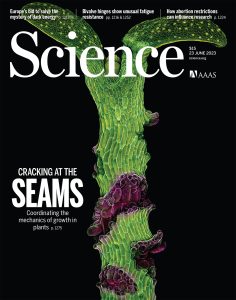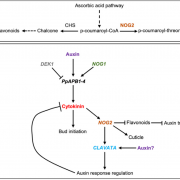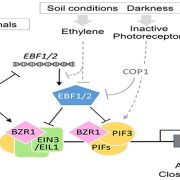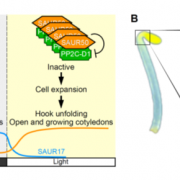Brassinosteroid coordinates cell layer interactions via cell wall and tissue mechanics
 Organismal growth requires extensive coordination between cells and tissues with different identities, and this is particularly important for plants with their rigid cell walls and lack of cell motility. A key mechanism for tissue coordination involving brassinosteroids has been identified by Kelly-Bellow et al. They started by looking at a dwarf mutant (isolated from an EMS-mutagenesis screen) of Utricularia gibba, an aquatic carnivorous angiosperm also known as humped bladderwort. The dwarf plants showed decreased epidermal cell elongation and the airspace-containing internal tissues were twisted. Modeling studies suggest that the phenotype is caused by inhibited growth in the epidermis. The affected DWARF gene encodes an enzyme involved in brassinosteroid biosynthesis, and the authors propose that brassinosteroids reduce mechanical epidermal constraint. Although a similar effect isn’t seen in brassinosteroid-deficient Arabidopsis plants, the Arabidopsis stems lack air spaces, so the internal tissues are held together more rigidly than in the floating aquatic plant stems. Therefore, the authors crossed a mutant that affects cell adhesion (quasimodo) with brassinosteroid deficient lines, leading to dramatic cracks in the epidermis as beautifully illustrated on the cover of Science. The authors propose that brassinosteroids alleviate growth constraints through cell wall modifications, and conclude that “Gene activity may therefore have coordinated effects on tissue development not only via molecular signaling but also via mechanics.” (Summary by Mary Williams @PlantTeaching) Science 10.1126/science.adf0752
Organismal growth requires extensive coordination between cells and tissues with different identities, and this is particularly important for plants with their rigid cell walls and lack of cell motility. A key mechanism for tissue coordination involving brassinosteroids has been identified by Kelly-Bellow et al. They started by looking at a dwarf mutant (isolated from an EMS-mutagenesis screen) of Utricularia gibba, an aquatic carnivorous angiosperm also known as humped bladderwort. The dwarf plants showed decreased epidermal cell elongation and the airspace-containing internal tissues were twisted. Modeling studies suggest that the phenotype is caused by inhibited growth in the epidermis. The affected DWARF gene encodes an enzyme involved in brassinosteroid biosynthesis, and the authors propose that brassinosteroids reduce mechanical epidermal constraint. Although a similar effect isn’t seen in brassinosteroid-deficient Arabidopsis plants, the Arabidopsis stems lack air spaces, so the internal tissues are held together more rigidly than in the floating aquatic plant stems. Therefore, the authors crossed a mutant that affects cell adhesion (quasimodo) with brassinosteroid deficient lines, leading to dramatic cracks in the epidermis as beautifully illustrated on the cover of Science. The authors propose that brassinosteroids alleviate growth constraints through cell wall modifications, and conclude that “Gene activity may therefore have coordinated effects on tissue development not only via molecular signaling but also via mechanics.” (Summary by Mary Williams @PlantTeaching) Science 10.1126/science.adf0752









